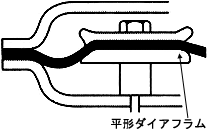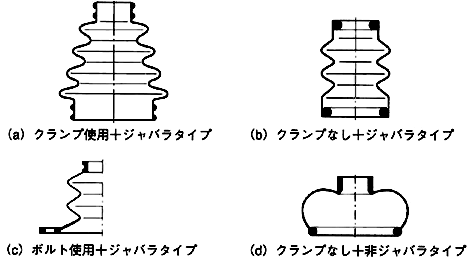Other seals
Description
Diaphragm
What is a diaphragm?
A diaphragm is a thin film laid between a moving component and a still component, preventing fluids or media in the two neighboring zones or chambers from mixing with each other.
Varieties of diaphragms
Diaphragms can be classified into the following three types:
- The diaphragms that are used solely for the division; there is no pressure difference between the two neighboring chambers.
- The diaphragms that are used for fixation; they operate as a division film. They are scarcely exposed to motion.
- The diaphragms that are used in a motional environment, sealing off between a moving component and a still component. In this application, the diaphragms transmit force and/or pressure.
Diaphragms can also be classified by another system, which divides them into flat diaphragms and rolling diaphragms. A flat diaphragm does not have a foldable part, or has a part foldable at an angle of no greater than 180 degrees. A rolling diaphragm is foldable at 180 degrees, and when a cylinder and a piston move relatively to each other, one side of the diaphragm moves away from the sidewall of the cylinder or piston while having rolling contact with it, while the other side starts having rolling contact with the sidewall.

Boot
What is a boot?
A boot is used on a joint that oscillates, rotates or reciprocates, to seal in the lubricant and prevent any ingress of external dust. In addition to use with joints, a boot may also be used to prevent any ingress of external dust between two components that operate with displacement. Therefore, boots are used in various applications such as automobiles, home appliances, construction machines, farming machines and iron-making machines. Using a boot whose shape and material suit the ambient conditions and operating conditions influences the performance of the application.
General requirements for boots
Boots are generally required to be:
- Resistant to enclosed oils and greases
- Resistant to ambient temperature (resistant to oil and grease)
- Highly resistant to ozone and water
- Highly resistant to wear and abrasion
- Highly resistant to permanent stress distortion around the fixed portions
A boot may be produced from such rubber materials as chloroprene rubber (CR), nitrile rubber (NBR) and silicone rubber (VMQ). A boot may also be made from such thermoplastic elastomers as thermoplastic polyester elastomers (TPEE) and thermoplastic polyolefin elastomer (TPO).
The following are typical shapes of boots.

Dust covers
What are dust covers?
A ball joint is used as a joint mechanism in the suspension and steering systems of automobiles, agricultural machines such as tractors, and construction machines such as forklifts. A dust cover is used to prevent a lubricant (grease) applied to protect the sliding surface of the ball joint from leaking out, and to prevent any ingress of muddy water or dust from outside.
General requirements for dust covers
Because ball joints are used in the suspension and steering systems, dust covers are exposed to water and dust, and are exposed to temperatures of -40°C in winter and +70°C in summer. They are also exposed to ozone in the ambient air. Therefore, the material characteristics the dust covers are required to meet are resistance to ozone, heat, low temperature, loss of resilience, wear, water, and oil. Generally they are made from chloroprene rubber.
